The “North Atlantic Financial Crisis” Heads South…
Australia was one of the only two OECD countries that did not record a recession during the GFC—the other being South Korea. In response, the RBA and Treasury took to describing the “Global Financial Crisis” as the “North Atlantic Financial Crisis” (see “Reserve Bank warns of interest rate growing pains” [SMH February 20 2010], or footnote 21 in this speech by Glenn Stevens), which implied that the GFC was caused by factors that were not relevant to Australia.
I noted at the time (“There is no GFC…”, Debtwatch, June 27th 2010) that the implication that the crisis was due to features of the North Atlantic financial system that Australia (and South Korea?) didn’t share was false, because it ignored the real cause of the crisis: runaway growth in private debt relative to income. The difference between the USA and Australia (and South Korea) was that this runaway growth ended in the USA, but kept right on going in Australia and South Korea.
Six years later, the consequences of this difference in the trajectories of private debt are starkly evident: the USA’s private debt is now 15% lower than when the GFC began (August 2007), while South Korea and Australia have climbed: South Korea’s debt level is 23% higher while Australia’s is a whopping 36% higher.
Figure 1
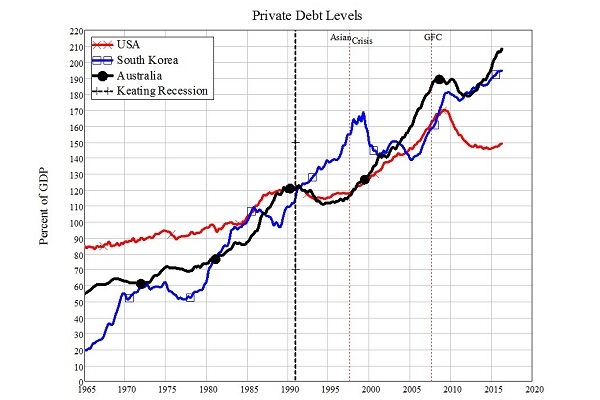
I’ve marked the Asian Crisis of 1997 and Keating’s “Recession we had to have” on the next chart to make a point that I’m used to conventional economists rejecting, without examining the evidence: that recessions occur when credit (which is the change in private debt) either drops substantially, or goes negative. There’s no denying that Australia and South Korea avoided recessions during the GFC, but equally there’s no denying that they had recessions in 1991 and 1997 respectively. In each case, credit went negative:
Figure 2
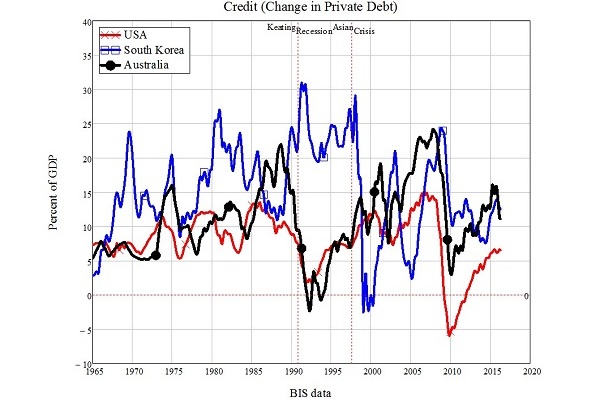
Now credit is declining in Australia again, and this—as well as the unwinding of the minerals boom—is behind the recent “unexpected bad news” on employment in Australia. But hey, let’s get to the important issue: what’s going to happen to house prices?
Have you noticed that when people dismiss the argument that there’s a house price bubble, they say it’s all due to supply and demand, and then ignore where demand comes from, and focus just on supply constraints? I thought I’d look at both supply and demand, and see what drops out.
The supply side of housing includes both the turnover of existing properties, and the supply of new properties onto the market. On the demand side, the money demand for houses comes overwhelmingly from new mortgage debt. Divide this new-mortgage-credit-financed demand for housing by the price index and you have the flow of demand. If the flow of demand exceeds the flow of supply, then there will be pressure for prices to rise.
A bit of mathematics results in an equation that expresses the rate of change of house prices as a function of both supply and demand, as both sides of the “Is there a bubble?” debate accept. However, what may be unexpected is that this equation includes acceleration terms for both mortgage debt and housing supply (see Figure 10, if equations are your thing).
The equation implies that for house prices to rise, the acceleration of mortgage debt must be positive, and greater (when deflated by the current monetary value of transactions on the housing market) than the supply-deflated sum of the rate of change of the existing housing stock up for sale, plus the rate of change of new construction (and thus the acceleration of the housing stock).
This equation helps make sense of the USA data on house prices and mortgage debt, which superficially have no consistent relationship: house prices and mortgage debt both rose from 1995 till 2007; then house prices fell while mortgage debt continued to rise till 2009; from 2009 till 2011, both house prices and mortgage debt fell; but from 2012 house prices have been rising while mortgage debt has still been falling (relative to GDP)—see Figure 3.
Figure 3
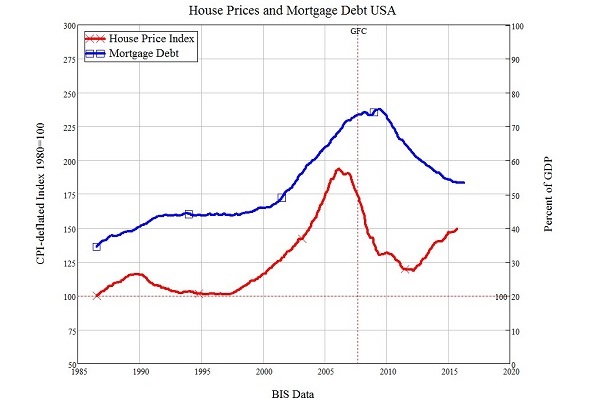
But when you plot the change in mortgage credit (which is the same as the acceleration in mortgage debt) against the change in house prices, a rather striking relationship emerges—see Figure 4.
Figure 4: Correlation 0.78
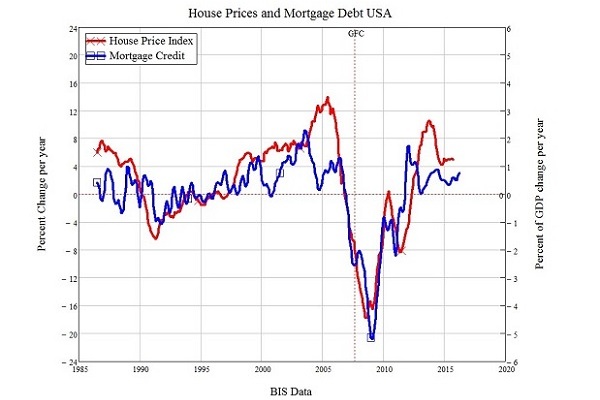
What about Australia? Here both total mortgage debt has climbed almost without pause since 1987, to be five times higher, relative to GDP, than it was thirty years ago. Real house prices have risen almost as relentlessly, to be three times what they were thirty years ago. This much is different to the USA—but hardly reassuring.
Figure 5
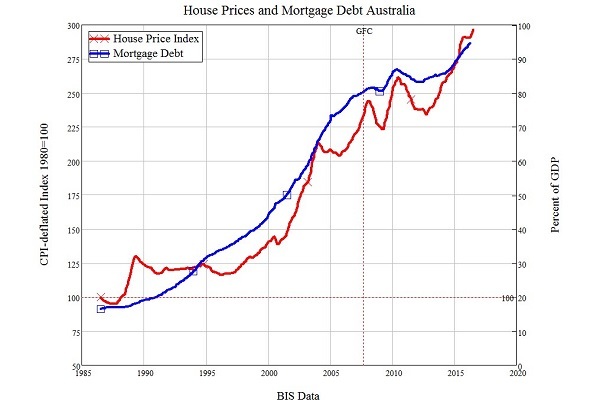
The acceleration and house price change data in Australia are far more volatile than in the USA, but the same basic relationship applies: house prices rise when mortgage credit is rising, and fall when it is falling. Mortgage credit is falling again right now, and the rate of increase of house prices is falling with it (see Figure 6).
Figure 6: Correlation 0.57 (0.76 since GFC)
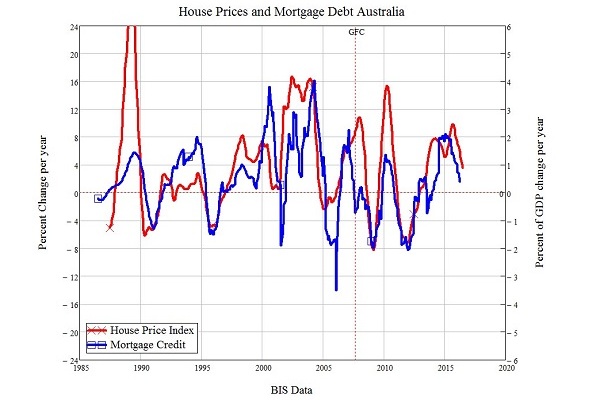
As it stands, the equation is agnostic about what causes what: rising prices could cause mortgage debt to accelerate, for example, or accelerating mortgage debt could cause house prices to rise. If the former were true, then the “No bubble” case would have legs: something else (such as rising population due to migration) would be causing rising prices, and mortgage debt would just be (pardon the pun!) the price you have to pay to get in on the market.
But if accelerating mortgage debt causes rising house prices, then every sustained rise of house prices faster than consumer prices is a bubble, because it requires not merely rising but accelerating mortgage debt for it to persist. Since nothing—not even mortgage debt—can accelerate forever, at some stage it will decelerate, taking house prices down with it because then the flow of demand is below the flow of supply.
So which is it? Do rising house prices cause rising mortgage credit, in which case only addressing the underlying causes of rising prices—such as population growth—or increasing supply can bring the rise to a halt? Or does rising mortgage credit cause rising house prices, in which case targeting the banking system’s proclivity to lend could end the bubble—and it could end of its own accord as mortgage debt stops accelerating?
Proving causality is notoriously difficult. The primary test for it in economics (“Granger causality”) strictly applies to linear models, and is therefore likely to return “false negatives” for nonlinear expressions like this equation—that is, to conclude that there is no causal relationship when in fact there is. So I was surprised when a colleague applied that test to the US data, and concluded that according to Granger causality, the causal relationship was definitely from mortgage debt to house prices, and not the other way around. The same result is likely to apply to Australian data, as we’ll check soon.
If so, Australian house prices have risen as much as they have primarily because of the unholy alliance between the banking sector and the political class, which has encouraged Australian households to continue leveraging themselves into mortgages ever since lending to the business sector hit the wall back in the “Recession we had to have” (see Figure 9). Since then, the change in mortgage credit (which is the acceleration of mortgage debt) averaged ¾ of a percent of GDP per year till the GFC, and about ½ a percent of GDP till now. Like a lead-footed car driver who hits the accelerator more often than the brake, this has taken Australian mortgage debt a long distance from its starting point of about 20% of GDP when the Keating Recession began to almost 100% of GDP now.
Figure 7
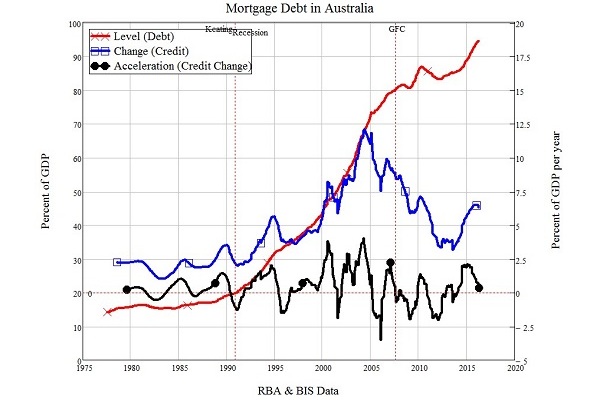
That trend cannot continue for much longer. Australia already has the world’s highest household debt to GDP ratio (tying for first place with Switzerland at 125.2%), and the second highest ever recorded (Denmark hit the world record level of 140.2% of GDP in 2010; it has since fallen to 123%, even though mortgage rates there are now effectively zero). The RBA might prolong the game by dropping rates further, but there are only six throws of that dice left before the government runs out of means to entice Australian households to keep on borrowing.
Figure 8
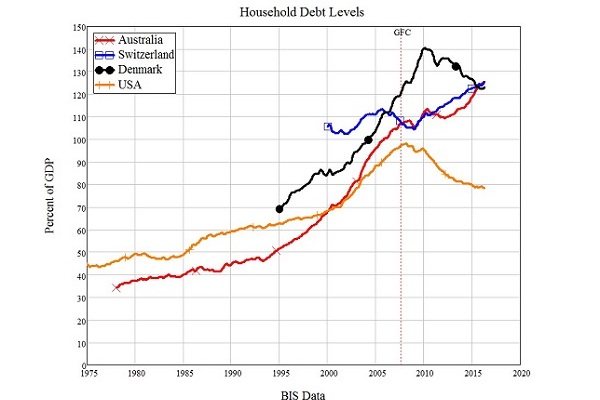
Long before Australia reaches its maximum household debt level, housing demand from mortgage credit will be well below housing supply, driving house prices down. The Australian house price bubble might still be saved by Chinese demand, if Australia encourages more foreign buying for the sake of property owners rather than limiting it for the sake of would-be local buyers as Vancouver has done. But with China cracking down on hot money outflows, as seems the case after the Crown Casino arrests, that’s relying on a very dangerous whale to save a very insignificant minnow. China could crush the market by forcing its nationals to repatriate money tied up in overseas property, just as easily as it could allow our bubble to continue. I wouldn’t take a bet on it.
Figure 9
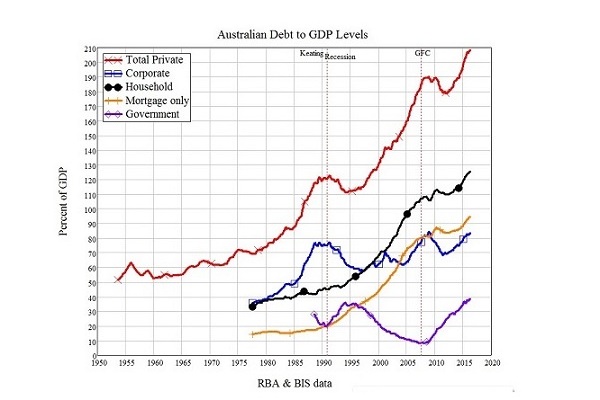
Figure 10
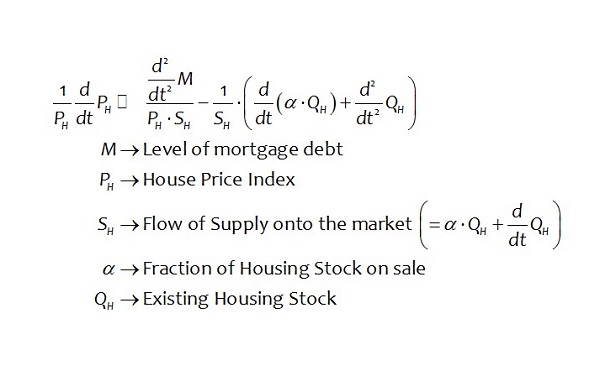
Comments
Got something to say? Post a comment...
You must be logged in to post a comment.





Thanks for the insights Steve.
If I’m hearing you correct, it’s the rate of change in mortgage debt (ie. easing of access to credit, rather than the nominal amount outstanding) that results in rising house prices rather than the reverse causation, or a simple correlation.
A common refrain I hear is that Australian mortgage origination and underwriting standards are prudent, certainly relative to the US circa 2005-2006, explaining the relative stability of Australian financials during and post the GFC.
Where’s the disconnect? If easy credit causes housing bubbles, how can prudent lending standards and housing bubbles coexist? Given only one can be true, and I’m assuming you’re running with the bubble thesis, what factors in current Australian mortgage finance do you consider imprudent?
Thanks Steve – I really value this kind of analysis and sensible commentary – god knows we don’t get anything useful on the news or from our politicians.
Of course we’re not getting anything useful from our politicians. Our Treasurer is basically a glorified Real Estate agent and our charismatic Prime Minister a party outsider who has his claws removed by a Liberal Party hell bent on keeping the magic pudding of “wealth through housing” going forever.
This sounds really scary. But beyond grasping that the outlook is gloomy, I’m afraid that I have no idea what you said Steve and I’ve read it twice.
It’s hard to refute your logic, Steve, unless of course you reject the idea that low interest rates are primarily driving property prices. There’s not too many people that would say that except Philip Lowe or maybe someone selling off-the-plan properties :)
If anyone wants a layman’s overview of Steve’s view, I wrote a summary of his article in Forbes earlier this year. You can find it
here.
Here’s my summary of this post if anyone finds it helpful:
– Australia’s private debt relative to income still had room to grow in 2008, and because the RBA began lowering rates to encourage more debt, debt kept growing, which spurred on our economy, so we didn’t feel the pain of the GFC Down Under.
– Australia’s private debt relative to income has continued growing since then and is now massive (biggest in the world and second biggest of all time).
– Recessions are inevitable when credit stops growing.
– Credit growth is starting to decline in Australia again.
– For house prices to rise, mortgage debt (where housing demand comes from) must be growing faster than housing supply.
– Aussie mortgage debt is five times higher than it was in 1987; house prices are three times higher over the same period.
– If our homes prices have risen primarily because of rising mortgage debt, then the growth is unsustainable because debt can’t keep growing forever.
– The RBA might keep lowering rates, which could keep households borrowing and home prices rising for a while longer, but eventually, the cash rate will be 0% and the RBA will be powerless to create more credit growth (barring QE).
– Even before that happens, housing supply will likely exceed demand (from credit growth), so home prices will start falling.
– Chinese investors may continue providing demand to prop up home prices, but that’s a long shot in light of their economic problems on the horizon.
– Investors should be cautious continuing to speculate on further growth in property values because we can’t predict exactly when credit will stop growing.
Thanks again Steve, great post.
thanks for this
only thing that concerns me is to not be the investor holding the baby, one thing I know for certain markets boom and then crash. The only reason markets are still strong IMO is low interest rates, however affordability will eventually put the brakes on.
I won’t take changes, have already taken my profits off the table in Sydney and Melbourne markets.
Dangerous to think booms last forever and markets are bullet proof
Marisa
MTR